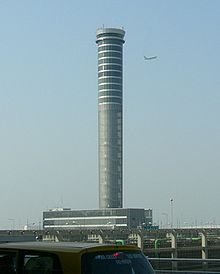Control tower
A control tower is a tower-shaped building,
the top is a control room, from which the traffic of a port, an airport or a racing circuit is directed and controlled. The location and height of the control center are essential to see the entire area to be controlled. The highest control tower, currently, is that of Suvarnabhumi International Airport, with 132.2 meters high.
Types of control towers
Air control towers
The air control tower is the control center from which air traffic control is carried out in the area of an airport and its surroundings, that is, control of taxiing, takeoff, the approach and landing of aircraft.
The control towers are in charge of separating takeoffs and landings from each other, and from those who cross over their area without the intention of landing, by issuing authorizations that must be obeyed by the pilots. For these authorizations, the weight and speed of the aircraft are taken into account, taking care that there is always a regulatory separation, or greater, between consecutive aircraft. Another criterion for assigning takeoff and landing turns is that the largest number of aircraft take off and land in the shortest time possible, to reduce delays, which may often require that the planes not always take off in the same order in that are ready, based on their speeds and performance.
Their work is complex, due to the large number of planes that transit and the atmospheric conditions that can alter said transit. For this, the aerodrome controller must, necessarily, have in view all the aircraft in his communication before authorizing them to enter his airspace, know perfectly the geography of his sector and have wind and atmospheric pressure measurement equipment., As minimum.
Currently complex automated systems are used to perform, under normal circumstances, the most common tasks with little or no human involvement. In this way the work is optimized and the probability of air accidents is reduced.
There are control towers that have suitable, trained and certified personnel 24 hours a day, and other towers with limited hours. Personnel can range from a single controller, to multiple people in the tower. Most commonly, there are two people in the control tower: a controller for the movements of aircraft and vehicles on the ground (known as Ground Control) and a controller for aircraft in the air (planes, helicopters, manned and unmanned balloons).; but there may be other controllers such as a supervisor responsible for the operation of the station; or coordinators who are in charge of exchanging information related to aeronautical operations with other dependencies of the same airport, such as departure or approach control, or with other airports.
The role of the ground controller is to give instructions for an aircraft or other vehicle to transit safely through the airport, usually heading to or from the runway.
Instructions that can be obtained from a ground controller include: Track in use; Direction and force of the wind; QNH - that is, the barometric pressure at sea level at that moment; or the QFE, which is the atmospheric pressure at the level of the aerodrome runway; the first (QNH) is used to refer to the elevation of the airport with respect to sea level and the second (QFE) to measure the height with respect to the touchdown point on the runway itself, air temperature; Local time; Visibility, expressed in meters, important data if there is fog in the sector. Other essential information, such as current weather phenomena that may affect flight safety, such as reporting hazards in the area, such as nearby birds, weather balloons, gusts of wind, or turbulence, among others.
The controller who monitors traffic in the air is in charge of coordinating by radio or telephone with the Radar Office, thus receiving traffic that arrives at the airport (and waiting for it visually), or handing over to Radar the surveillance of air traffic that take off from the airport.
The idea that the control tower is located so high is solely because it will be easier for controllers to see movements of aircraft in the air or on the ground. In other words, the control tower is an observation office in the first place (because of its height), and a direction office in the second place (because it is equipped with radio equipment).
Port control towers
Less widespread than airport towers, port control towers direct traffic in ports of a certain size, and compact enough for effective visual control from the tower.
Contenido relacionado
Line D (Buenos Aires subway)
Renault 7
Batport

